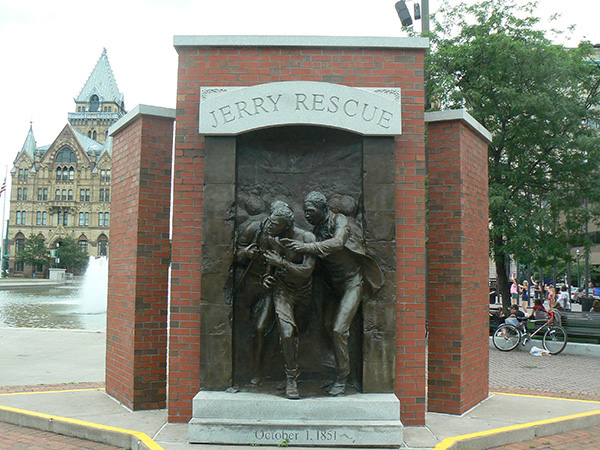
On October 1st, 1851, an escaped slave named William Henry, known as Jerry and had lived in Syracuse since 1843, was seized at work by five U.S. Marshals and taken to the Townsend Block at the southeast corner of Clinton and Water streets near the Erie Canal for a hearing.
After a failed escape attempt, Jerry was moved to the police station. Jermaine Loguen, a former slave from Tennessee who came to Syracuse in 1841 as a Methodist minister, and Samuel May, a Unitarian minister, formed a plan to help Jerry. He was captured as part of the Fugitive Slave Acts. What were these laws? History.com explains,
A large crowd of people, who were in the city for an anti-slavery convention, had gathered in front of the building where Jerry was being held. Upon a signal from the leaders, the crowd broke into the jail, freed Jerry, and helped him escape to Canada.
In a speech by Rev. Samuel J. May to the Convention of Citizens, of Onondaga County delivered just two weeks after the Jerry Rescue, May captured the sentiment of the crowd in stirring terms:
But when the people saw a man dragged through the streets, chained and held down in a cart by four or six others who were upon him; treated as if he were the worst of felons; and learnt that it was only because he had assumed to be what God made him to be, a man, and not a slave—when this came to be known throughout the streets, there was a mighty throbbing of the public heart; an all but unanimous up rising against the outrage. There was no concert of action except that to which a common humanity impelled the people. Indignation flashed from every eye. Abhorrence of the Fugitive Slave Bill poured in burning words from every tongue. The very stones cried out.
In a postscript to this account, May added these comments:
It was pretty generally known throughout the country, that there is prevalent in this city and county, a strong anti-slavery sentiment, and, more especially, a deep abhorrance [sic] of the Fugitive Slave Law. As if on purpose to set this public feeling at defiance, and challenge us to make it manifest, Mr. Webster declared to an assembly of our citizens last June, that that execrable law should be enforced here; ay, in the midst of the next Anti-Slavery Convention, that should be held in this city. Such a threat was not adapted to allay the rising of an opposite determination. We are not all here quite so craven, and slavish as to bow at once submissively to such a brow-beating as he attempted to give us. His words rankled in the bosoms of a great many. This too was well known.
A monument was added to Clinton Square (photographed above) in 1990 to commemorate the event that became known as the Jerry Rescue.
— Daniel Connors of the OHA with additional information via Syracuse University Library and History.com

